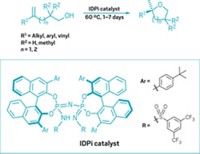Advertisement
Grab your lab coat. Let's get started
Welcome!
Welcome!
Create an account below to get 6 C&EN articles per month, receive newsletters and more - all free.
It seems this is your first time logging in online. Please enter the following information to continue.
As an ACS member you automatically get access to this site. All we need is few more details to create your reading experience.
Not you? Sign in with a different account.
Not you? Sign in with a different account.
ERROR 1
ERROR 1
ERROR 2
ERROR 2
ERROR 2
ERROR 2
ERROR 2
Password and Confirm password must match.
If you have an ACS member number, please enter it here so we can link this account to your membership. (optional)
ERROR 2
ACS values your privacy. By submitting your information, you are gaining access to C&EN and subscribing to our weekly newsletter. We use the information you provide to make your reading experience better, and we will never sell your data to third party members.
Synthesis
Lewis Acid-Base Combo Generates A Lactam
Two catalytic cycles work concurrently, then combine, to create a substituted γ-lactam
by Jyllian N. Kemsley
July 19, 2010
| A version of this story appeared in
Volume 88, Issue 29
Two catalytic cycles, one using a Lewis base and the other a Lewis acid, can work concurrently to combine a hydrazone and an aldehyde to create a substituted γ-lactam ring, report Karl A. Scheidt and colleagues at Northwestern University (Nat. Chem., DOI: 10.1038/nchem.727). These substituted, five-membered rings typically have biological activity and are common in natural products. Scheidt and coworkers took a cue from biological systems that use acids and bases to activate substrates in an enzyme active site and developed a cooperative catalytic system that uses an N-heterocyclic carbene (NHC) as a Lewis base and magnesium di-tert-butoxide as a Lewis acid. The carbene adds to the aldehyde to generate a nucleophilic enediamine. Meanwhile, the magnesium compound complexes with and activates the hydrazone. The enediamine then adds to the hydrazone, and an intramolecular acylation closes the γ-lactam ring, releasing and regenerating the N-heterocyclic carbene. Finally, the magnesium compound dissociates. The system works with a variety of hydrazone and aldehyde substrates with good yields and high diastereo- and enantioselectivity.





Join the conversation
Contact the reporter
Submit a Letter to the Editor for publication
Engage with us on Twitter